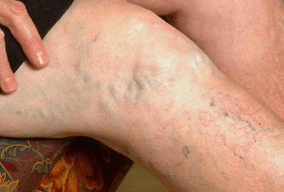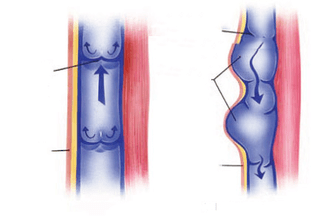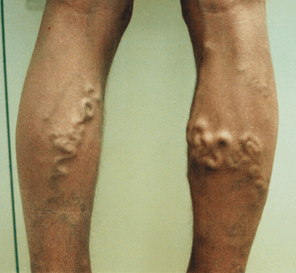
Varicose veins of the leg is a chronic disease. Varicose veins can be caused by genetic factors, a passive lifestyle, and heavy loads on the legs and blood vessels. Varicose veins are common during pregnancy.
In pregnant women, the load on the legs is increased, edema often occurs, against these background clots and other vascular problems may appear, leading to varicose veins.
When you have the first symptoms of varicose veins (swelling of the veins, mesh veins in the legs, severe swelling of the legs, pain in the legs and feet), you should consult your doctor. vein. A thorough examination will be required to confirm the diagnosis and extent of varicose veins. After getting the necessary data, your doctor will tell you how to treat varicose veins, prescribe the necessary medications and procedures.
Who specializes in varicose veins?
When suffering from varicose veins, many patients do not know which doctors treat varicose legs? All vascular diseases are treated by a vein doctor. Phlebologist is a narrow medical specialty involved in the diagnosis and treatment of venous diseases.
Naturally, you should not see a vein doctor if the varicose veins are in a severe stage. You should have a personal vein doctor, who can view the development of venous diseases in the early stages and prescribe treatment.
If you have varicose veins, you should contact a vein specialist - a vein doctor
How to treat varicose veins

Varicose veins is one of the most unpleasant and dangerous diseases, to be cured effectively requires using many different means. Treatment of varicose veins like? Varicose veins can be treated by choosing one of the methods.
The choice of treatment for varicose veins depends on the severity of the disease and the individual characteristics of the human body. The procedure for treating varicose veins must be approved by a doctor. Among the ways to combat varicose veins of the legs, the following effective techniques can be distinguished:
Sclerotherapy
The essence of this technique is that a special substance (emollient) is injected into the diseased veins using a thin needle.
Atheroma, penetrates the vein, leads to adhesion of its walls and removes the affected vessel from the network of common blood channels on the leg.
Treatment helps to get rid of small varicose star marks after 3-5 weeks and after three months, the large varicose nodules and bumps will disappear.
Phlebectomy
This technique is used for severe varicose veins. Surgery is performed when varicose veins lead to the appearance of large nodes and seals in the veins, causing the appearance of large blood clots. A significant disadvantage of surgical interventions for varicose veins is the scarring and scarring of the skin.
Laser varicose therapy is used as a convenient and completely painless treatment for varicose veins. The laser applied to the affected vessel follows the same principle as for sclerotherapy. The walls of the blood vessels are welded under the action of a laser, but it will take a long time to effectively treat varicose veins. One positive aspect of laser therapy for varicose veins is that there is no scarring of the skin.
Aspiration therapy or varicose therapy with leeches. Varicose leeches are commonly used by believers in natural medicine. This does not mean that the hirudotherapy technique is effective, it has a lot of drawbacks. To get a clear effect of hirudotherapy, you need to go through several sessions, each - 8 sessions. Treatment of varicose veins with leeches is only effective in the early stages of vascular disease.
Prevention of varicose veins
Varicose veins begin to manifest in the form of severe pain or bouts in the legs, vascular meshing on the skin of the legs and protruding veins of blue color.
You should warn about varicose veins in advance, rather than then look for different remedies. Here are some precautions that can help prevent the development of varicose veins.
- Avoid wearing uncomfortable and tight heels. From the uncomfortable shoes in the blood vessels of the leg, the pressure increases, leading to the formation of blood clots and the development of varicose veins.
- Regular exercise can help you avoid varicose veins. Take time each day for walking, running, dancing, and swimming. Varicose veins most commonly develop in shopkeepers, hairdressers, and flight attendants. Why is this trend observed? The feet of such workers during the day receive a very large static load due to long standing. As a result, the development of varicose veins.
- Must be constantly monitoring the body weight, because the extra weight increases the load on the vessels in the legs and increases blood pressure on the vessel wall.
- It is recommended to regularly arrange walking barefoot on different rough surfaces (pebbles, sand, hay). In this way, the firmness of the veins in the leg is achieved, and the muscles in the legs are well relaxed and rested.
- Not regularly eating salty and spicy, alcoholic beverages. All spicy and salty foods contribute to the formation of blood clots and the development of varicose veins. You can thin thickened blood with plain water or unsalted tomato juice.
- Varicose veins often cause an unpleasant phenomenon like cellulite. How to treat cellulite with varicose veins? For a patient with varicose veins, several procedures are contraindicated to effectively combat cellulite. Therefore, the doctor must select an individual varicose treatment plan, which will prescribe the method of dealing with the cellulite condition. With varicose veins, it is allowed to use a limited number of procedures aimed at removing signs of cellulite. These treatments include green clay leg wraps, contrast water treatments, swimming, and brisk walking. With varicose veins, exposure to high temperatures on the affected areas of the legs is extremely undesirable. For this reason, it is necessary to give up entraining in the fight against cellulite. With varicose veins, you are not allowed to go to the baths and saunas, go to the solarium, and massage the swollen legs. With varicose veins, an electrical load is contraindicated. Therefore, people with varicose veins will not be able to get rid of cellulite under heavy exercise.
Varicose veins - when to see a doctor?
The first symptoms of early varicose veins were already a sign to see a specialist. The main signs of varicose development are:
- Severe and fatigue in legs, edema
- Night cramps in calves.
- Burning and pain in the legs.
- Varicose veins
- Small spider veins or large swollen veins on the surface of the skin.
Varicose veins can occur not only in the lower extremities. Also known as varicose veins of the small pelvis, varicose veins of the uterus, varicose veins of the esophagus or genitals. With the development of one of these types of varicose veins, the following symptoms will appear:
- Severe pain in the lower abdomen
- A vein in the groin opens
- Unpleasant genital discharge
- Pain during sex
- Pain in your sacrum and lower back increases with the onset of your period
- The menstrual cycle is interrupted, menstruation is prolonged with dirty discharge.
The listed symptoms are nonspecific, they may signal other conditions. In any case, if you suspect varicose veins, it is better to see a competent specialist to make an accurate diagnosis and prescribe the necessary procedures.
Diagnosis of varicose veins

Diagnostic measures to determine the degree of varicose veins begin to be taken by the doctor right from the moment the patient applies. If the first stage of varicose veins is diagnosed, conservative treatment is given. That is why it is not advisable to postpone visiting your doctor if you suspect varicose veins.
To accurately diagnose varicose veins and the extent of its complications, a comprehensive examination is carried out by hardware and laboratory engineering. Patients must pass necessary tests to perform clinical and laboratory research, as well as undergo a number of procedures.
In particular, it is necessary to do three-dimensional ultrasound, dopplerography of blood vessels, conduct minimally invasive assessment of venous blood flow. For an accurate diagnosis, you'll need an intravenous X-ray (a special procedure in which radioactive contrast is injected into a diseased vein), to check the pressure in the vein over time.
Based on the results obtained, the venomist makes a comprehensive conclusion about the presence of varicose veins in one degree or another.
Oriental medicine for varicose veins
Varicose veins are a common disease that in most cases cannot be treated with conventional medications.
Varicose veins often occur in pregnant women who are not taking strong medications.
That is why a proven home remedy for varicose veins at home with traditional medicine is increasingly being practiced.

- With varicose veins, the great water of the chamomile works, you need to drink it three times a day, once a glass. Chopped hop cones (1 tbsp) must be poured with boiling water and a little bit soft.
- Apple cider vinegar to treat varicose veins is used both externally and internally. Drink apple cider vinegar diluted with water, one tablespoon per day. The varicose leg areas are massaged with pure apple cider vinegar, if there are no lesions and sores on the skin.
- Before going to bed, you can apply raw potatoes or finely chopped green tomatoes to the veins and swelling.
- For the treatment of varicose veins with folk remedies, you can prepare a special ointment from the collection of herbs. You will need one teaspoon of dried chamomile herb, St. seaweed. John's, chicory, shiitake mushrooms and meadowsweet. The entire herbal collection is poured with water in the amount of 1 ml, and simmered until boiling. After boiling, you need to add badger fat to the composition. For a week, the ointment should be applied to swollen venous leg areas, wrapping the legs with a food wrap.
Traditional remedies are not always effective for long-term varicose veins, but effectively tighten the veins and veins of the legs. Alternative treatment for varicose veins can be used in the absence of opportunity for drug therapy.
You can reduce your risk of developing varicose veins by following the right diet and participating in regular physical activity. Varicose veins can be completely cured with surgical intervention, which is performed after a complete examination of the venous specialist.












































